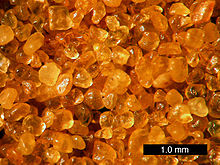Quartz
![]()
The title of this article is ambiguous. For other meanings, see Quartz.
Quartz, also called deep quartz or α-quartz, is a mineral with the chemical composition SiO2 and trigonal symmetry. It is the stable form (modification) of silica on the Earth's surface and the second most abundant mineral in the Earth's crust after feldspars. At a temperature of over 573 °C (under a pressure of 1 bar), low quartz changes into high quartz by changing the crystal structure.
With a Mohs hardness of 7, quartz is one of the hard minerals and serves as a reference value on the scale according to Friedrich Mohs, which extends to 10 (diamond). It often forms well-developed crystals of great variety of shapes and colours, whose crystal surfaces exhibit vitreous luster. Quartz has no cleavage, breaks conchoidally like glass and shows a greasy luster on the fracture surfaces.
In industry, quartz is one of the most important minerals and is equally important worldwide as a building material and as a raw material for the ceramics, glass and cement industries. Quartz gravel and crushed quartz are raw materials for the extraction of silicon.
In addition, quartz and its coloured varieties have been valued as gemstones since ancient times (see use).
Quartz crystals are also produced artificially: Oscillating quartz crystals cut from them are used as clocks in electronic circuits and quartz watches.
Occasionally quartz is confused with calcite, but can be easily distinguished from it by its greater hardness, lower birefringence, and the reaction of calcite with dilute hydrochloric acid.
Etymology and history
The term is first attested in the 1st half of the 14th century in East Central German as a technical word of Bohemian mining (quarz). There are various hypotheses as to its origin. According to one of these hypotheses, it comes from Mhd. querch ('dwarf') in reference to the superstition that mountain spirits undermined the mining-worthless mineral after they had "robbed" a valuable ore originally present at the same place (cf. also the etymology of cobalt). Another hypothesis is that quartz comes from kwardy, an expression from a Polish dialect, which corresponds to the Czech vocabulary tvrdý ('hard'). According to a 1942 hypothesis by Sergei Ivanovich Tomkeieff, the word is supposed to be a contraction of the Saxon miner's expression 'Querklufterz'. Tomkeieff presupposes the form quertz, querz as the basic form, which can be found in 16th century writings such as Ein nützlich Bergbüchlin and Agricola's De re metallica with reference to the language use of Saxon miners. However, in the seventh volume of the Grimm's dictionary, published in 1889, similar derivations existing since the 16th century, which assume a contraction from quaterz, quaderz ('evil ore') or from gewarz, gewärze (collective term for wart), are described as "playful attempts to fathom the origin of the word".
Quartz has become internationally accepted as a mineral name, with slight, language-specific variations such as quartz in English and French, kvarts in Swedish, quarzo in Italian, or кварц (black) in Russian.

Quartz sand from Coral Pink Sand Dunes State Park, Utah; the orange coloration is due to hematite overlay.
Classification
According to the 8th and 9th editions of Strunz's Systematics of Minerals, quartz belongs to the mineral class of oxides with a metal-oxygen ratio of 1:2 due to its chemical composition.
In the 8th edition of the mineral systematics it is also the eponym for a group of chemically similar or identical minerals, the quartz group, whose other members are coesite, cristobalite, melanophlogite, mogánite, opal, stishovite and tridymite.
The 9th edition of the mineral systematics according to Strunz, however, subdivides the oxides more finely. Quartz as well as the minerals related to it beta quartz (existence so far only as synthesis known) coesite, cristobalite, melanophlogite, mogánite, seifertite, opal, stishovite and tridymite are now assigned to the subdivision (Chemical compounds) With small cations: Silica family. However, lechatelierite (silica glass), which is also listed in the systematics, still has a questionable mineral status and is therefore not recognized as an independent mineral by the International Mineralogical Association (IMA).
The systematics of James Dana orders the minerals according to their crystal structure. In quartz, silicon is tetrahedrally surrounded by four oxygen atoms. These SiO4 tetrahedra are linked via their corners to form a three-dimensional framework, and quartz is therefore assigned to the framework silicates in Dana's systematics.
Questions and Answers
Q: What is quartz?
A: Quartz is a tectosilicate mineral that is the second most common mineral in Earth's continental crust. Its crystal structure consists of SiO4 silicon–oxygen tetrahedra, and its overall chemical formula is SiO2 or silica.
Q: Where does the name "quartz" come from?
A: The word "quartz" comes from the German word "quarz".
Q: What are some varieties of quartz?
A: Some varieties of quartz include agate, amethyst, rose quartz, clear quartz, smoky quartz, tiger's eye, lemon quartz, jasper, onyx, agate and carnelian.
Q: How hard is quartz?
A: Quartz has a mineral hardness of 7 on the Mohs scale.
Q: What is fused quartz?
A: Fused quartz is glass made of silica in non-crystalline form. It does not contain other ingredients that are added to other glass to lower the melting point and has high working and melting temperatures.
Q: What products can fused quartz be used for?
A: Fused silica can be used in a number of high-tech products due to its purity.
Q: How long have people been using different types of quartz for jewelry and carvings?
A: People have been using different types of quartz for jewelry and hardstone carvings for a long time.
Search within the encyclopedia